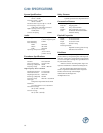
6
CONNECTIONS
The C200 has 1/4˝ TS and Speakon™-
style INPUT and THRU connectors. The
connectors are wired in parallel, so use only
one of the input connectors (either 1/4˝ TS
or Speakon-style).
INPUT THRU
PARALLEL
C200 Connector Panel
Normally, you would use only one
THRU connector, but it is possible to use
both THRU connectors. Keep in mind that
all the speakers are connected in parallel, so
you want to be sure not to go below the
minimum impedance requirements for
your amplifier.
The C200 has a nominal
impedance of 8 ohms.
Two C200s in parallel
equals 4 ohms.
Three C200s in parallel
equals 2.7 ohms.
Four C200s in parallel
equals 2 ohms.
Use high-quality speaker cable as recom-
mended by the manufacturer.
DO NOT use coaxial
shielded cable like a gui-
tar cord to make speaker
connections. They are
not designed to handle
the high currents re-
quired to drive a
loudspeaker.
The 1/4˝ TS jack is wired as follows:
Tip = Signal (“+” or hot)
Sleeve = Ground (“–” or cold)
SLEEVE
("–" or COLD)
TIP ("+" or HOT)
TIPSLEEVE
TIP
SLEEVE
1/4˝ TS Connector
The Speakon-style connector is wired as
follows:
Pin 1+ = Signal (“+” or hot)
Pin 1– = Ground (“–” or cold)
Speakon-style Connector
PLACEMENT
The C200 loudspeakers are designed to sit
on the floor, a tabletop, or to fit on a standard
tripod speaker stand. They can also be sus-
pended by the rigging points, which requires
installing the optional accessory plates on
the top and bottom of the cabinet.
You can lay the cabinet down on its side
and use the C200 as a floor monitor. The
asymmetrical trapezoidal shape of the cabinet
provides a perfect angle for aiming up toward
performers from the front of the stage.
Warning: Do not stack
speakers in a column.
This is to avoid the
danger of toppling
speakers.
As with any loudspeakers, protect them
from moisture. If you are setting them up
outdoors, make sure they are under cover if
you expect rain.
COLD
HOT
1+
1+
1–
1–
2–
2+














